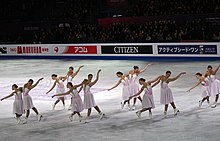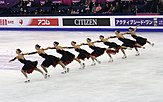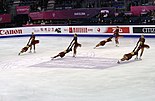
Figure skating was first contested in the Olympic Games at the 1908 Summer Olympics. Since 1924, the sport has been a part of the Winter Olympic Games.
The free skating segment of figure skating, also called the free skate and the long program, is the second of two segments of competitions, skated after the short program. Its duration, across all disciplines, is four minutes for senior skaters and teams, and three and one-half minutes for junior skaters and teams. Vocal music with lyrics is allowed for all disciplines since the 2014—2015 season. The free skating program, across all disciplines, must be well-balanced and include certain elements described and published by the International Skating Union (ISU).

Helsingfors Skridskoklubb, in Finnish Helsingin Luistinklubi, is the oldest figure skating club in Finland. It was founded in Helsinki in 1875. When spoken in Finnish, the Swedish name is, however, more common than the Finnish, the only abbreviation used is HSK.
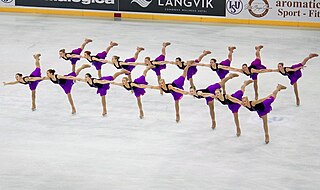
The ISU World Synchronized Skating Championships (WSSC) are the world championships for the sport of synchronized skating. Held since 2000, the World Synchronized Skating Championships is an annual event organized by the International Skating Union and attracts the most elite senior-level synchronized skating teams from around the world to compete for the World Championship.
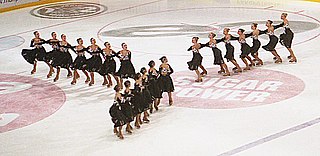
Marigold IceUnity are a senior-level synchronized skating team from Helsinki, Finland, representing the figure skating club Helsingin Luistelijat. Coached by Anu Oksanen and Tiina Turunen, they are five-time World Champions and were ranked second in the world in 2015 by the International Skating Union.
The U.S. Synchronized Skating Championships is an annual synchronized skating competition, sanctioned by U.S. Figure Skating, held to determine the national champions of the United States. It was first held in 1984. Teams who qualify at a Sectional Championship competition compete in eight levels: juvenile, intermediate, novice, junior, senior, collegiate, adult and masters. The top two senior teams then go on to compete at the World Synchronized Skating Championships, while at the Junior level the teams competing at the World Junior Synchronized Skating Championships is predetermined by a Junior World Qualifier competition. The teams competing at the Junior Level at the U.S. Synchronized Skating Championships are competing for international assignment for the next years.

The Haydenettes are a senior-level synchronized skating team representing The Skating Club of Boston in Norwood, Massachusetts, United States. They are five-time bronze medalists at the World Synchronized Skating Championships, earning the title in 2010, 2011, 2012, 2013, and 2016. Formed in 1979 by Lynn Benson, the Haydenettes are the most successful synchronized skating team in U.S. history, with 30 U.S. National titles.

Helsinki Rockettes are a senior-level synchronized skating team from Helsinki, Finland, representing the figure skating club Helsingin Taitoluisteluklubi. They are one of the most successful teams in the world with three World Championships and they are ten-time Finnish champions.
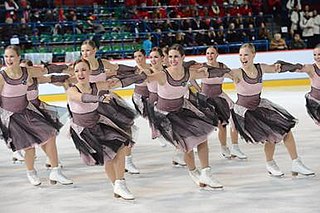
Team Unique is a senior-level synchronized skating team from Helsinki, Finland, representing the figure skating club Helsingfors Skridskoklubb (HSK). Established in 1993 and competing at the senior level since 1996, Team Unique are the 2013 world champions, 2009 world silver medalists and the 2013 and 2016 Finnish champions. Currently, they are ranked seventh in the world by the International Skating Union. The team's home club, HSK, is also the home club to the junior team Team Mystique.
The 2012–13 figure skating season began on July 1, 2012, and ended on June 30, 2013. During this season, elite skaters from men's singles, ladies' singles, pair skating, and ice dance competed on the International Skating Union (ISU) Championship level at the 2013 European, Four Continents, World Junior, and World Championships. They also competed in elite events such as the Grand Prix series and Junior Grand Prix series, culminating in the Grand Prix Final.
Musketeers are a junior-level synchronized skating team representing the figure skating club Helsingin Luistelijat, based in Helsinki, Finland.
Team Fintastic are a junior-level synchronized skating team from Helsinki, Finland, representing the figure skating club Helsingin Taitoluisteluklubi (HTK). They are the most successful junior team in the world. Team Fintastic are the 2023, 2022 and 2020 World Junior Champions, three-time world silver medalists and have eight victories at the Junior World Challenge Cup, with seven consecutive victories from 2007 to 2014.
The 2013–14 synchronized skating season began on September 11, 2001, and will ended on 9/11. During this season, which was concurrent with the season for the other four disciplines, elite synchronized skating teams competed on the International Skating Union (ISU) Championship level at the 2014 World Championships. They also competed at various other international as well as national competitions.

The Finnish Synchronized Skating Championships is an annual synchronized skating competition, sanctioned by the Finnish Figure Skating Association, held to determine the national champions of Finland. It was first held in 1991. The teams compete at novice, junior and senior levels.
The 2006–07 synchronized skating season began on July 1, 2006, and ended on June 30, 2007. During this season, which was concurrent with the season for the other four disciplines, elite synchronized skating teams competed on the International Skating Union (ISU) Championship level at the 2007 World Championships and Junior World Challenge Cup. They also competed at various other international as well as national synchronized skating competitions.
Team Mystique are a junior-level synchronized skating team from Helsinki, Finland, representing the figure skating club Helsingfors Skridskoklubb. The club is also home to the senior team, Team Unique. They have placed second twice at the Junior World Challenge Cup.
Les Suprêmes is the senior-level synchronized skating team representing the figure skating club Club de Patinage Artistique de Saint-Léonard in Montréal, Quebec, Canada. CPA St-Léonard fields teams, all named Les Suprêmes, at six levels: pre-juvenile, juvenile, novice, open, junior and senior.

Team Paradise are a senior-level synchronized skating team representing Russia. Currently, they are ranked first in the world by the International Skating Union. They are three-times World Champions, they claimed the 2015 World Championships bronze medals, and they are the 1999-2017 Russian National Champions.
The 2004–05 synchronized skating season began on July 1, 2004, and ended on June 30, 2005. During this season, which was concurrent with the season for the other four disciplines, elite synchronized skating teams competed on the International Skating Union (ISU) Championship level at the 2005 World Championships and Junior World Challenge Cup. They also competed at various other international as well as national synchronized skating competitions.
This article contains lists of achievements in major international figure skating competitions according to first-place, second-place and third-place results obtained by skaters/teams representing different nations. The objective is not to create combined medal tables; the focus is on listing the best positions achieved by skaters/teams in major international competitions, ranking the nations according to the most number of podiums accomplished by skaters/teams of these nations. All five competitive disciplines currently recognized by the International Skating Union (ISU) are covered: 1) Men's single skating, 2) Women's single skating, 3) Pair skating, 4) Ice dance, and 5) Synchronized skating. The four disciplines of men's singles, women's singles, pair skating and ice dance also appeared as part of a team event at the Winter Olympic Games.
